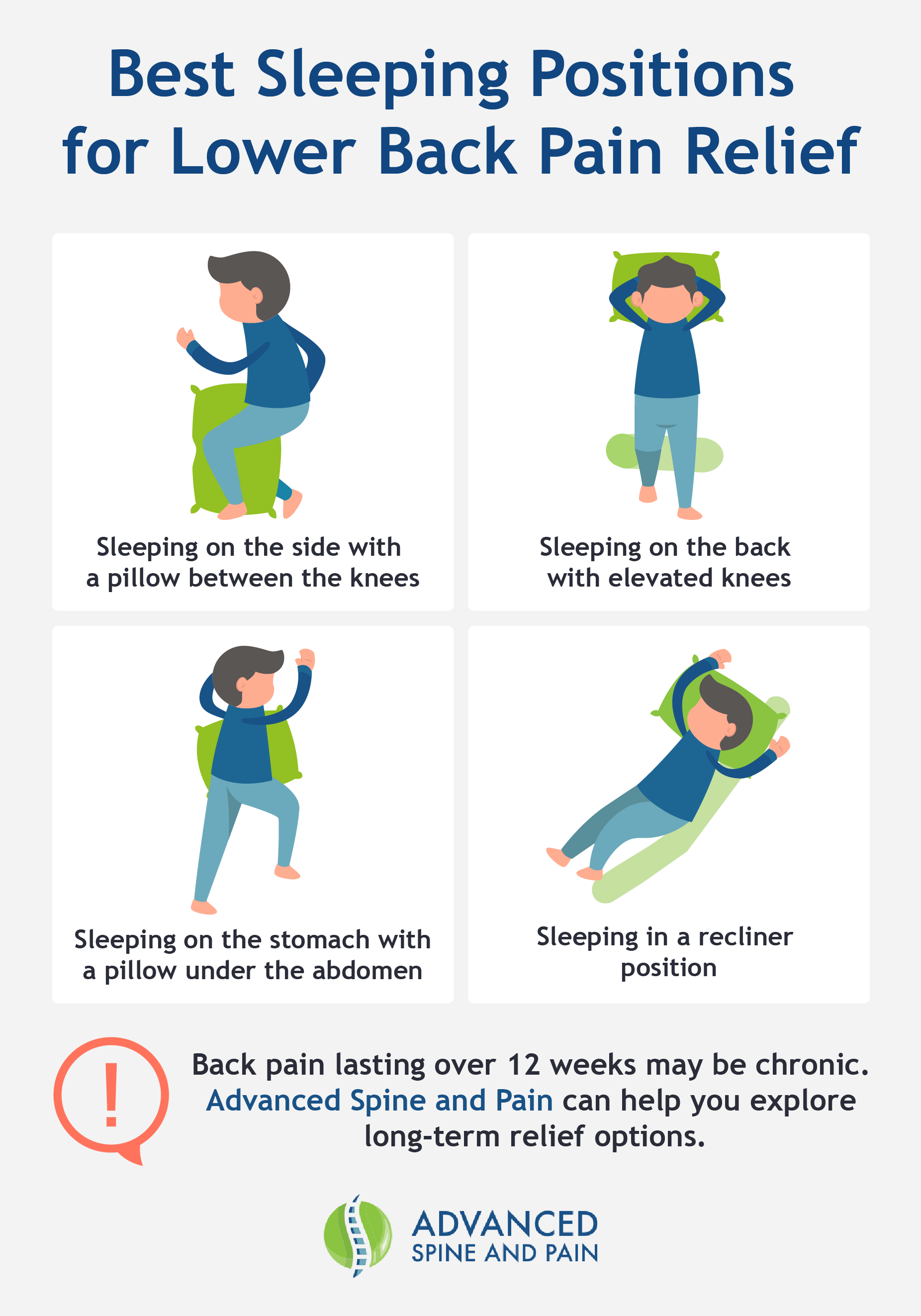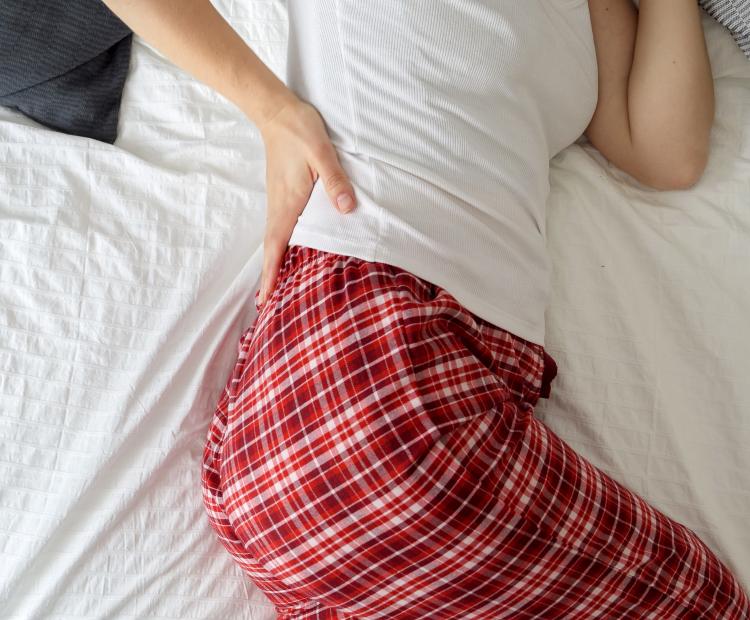It’s well-known that lower back pain interferes with everyday activities. Those with lower back pain might miss days of work, lose the ability to participate in hobbies, or even have issues executing simple tasks without any discomfort.
But lower back pain doesn’t end when you go to bed at night: it can even stop you from getting rest. Knowing how to sleep more comfortably with lower back pain can help you avoid sleep deprivation and heal faster.
At Advanced Spine and Pain, we help people with lower back pain every day. We can help you plan the proper treatment to stop lower back pain in its tracks and provide advice on how to get quality sleep despite lower back pain. Contact us online or call 480-573-0130
to learn more about managing your lower back pain.
What Causes Lower Back Pain?
There are many causes of lower back pain. For example, sprains, strains, injuries, and inflammation from conditions like arthritis can all lead to pain in the back’s bones, muscles, nerves, and ligaments. Some common causes include:
- Injuries due to sprains or strains, either from heavy lifting, overuse, or accidents
- Vertebral fractures due to an injury or osteoporosis
- Degenerative disc disease or herniated discs
- Spinal stenosis, a condition that is more common in older adults and results in narrowing of the spinal column 1
- Spondylolisthesis, where a part of the spine slips out of alignment 2
- Arthritis
- Problems unrelated to the spine, like kidney stones or other health concerns
- Tumors (in rare cases)
What Are the Symptoms of Lower Back Pain?
Several common symptoms of low back pain can make sleeping difficult. In some cases, multiple symptoms may be present simultaneously, adding to the discomfort. These symptoms include:
- Muscle aches or muscle spasms
- Stiffness
- Pain that radiates down to the buttocks or legs (sometimes called sciatica)
- Pain that worsens with movement
- Pain that worsens with rest
- Constant pain (chronic pain)
- Intermittent pain
- A combination of several kinds of pain: dull, sharp, burning, or aching
How to Sleep with Lower Back Pain
Sometimes, laying down at night can make back pain worse. Fortunately, there are ways to help improve comfort while you sleep, starting with adjusting your sleeping position:

Tip 1: Lie on your side with your knees slightly bent
This sleeping position is also described as the fetal position. The angle helps open space between the vertebrae where inflammation, nerve pain, and compressed discs can cause increased pain. A pillow can also be added between the knees or a body pillow for more comfort.
Hint: this is the best sleeping position for back pain!
Tip 2: Use a pillow to elevate the knees
If you sleep on your back, propping up your knees can shift your spine into a more comfortable position.
Tip 3: If you sleep on your stomach, use a pillow
Lying on your stomach can increase back pain, but if you’re a stomach sleeper, using a pillow under your lower abdomen and hips can help support the curve of your spine to reduce pain. This is especially helpful if you have degenerative disc disease.
Tip 4: Sleep on an incline
Sleeping partially reclined can be a more comfortable sleeping position than lying flat. If possible, the head of the bed could be raised to create a steady incline.
Tip 5: Use a supportive sleeping surface
The surface on which you sleep also affects back pain. This can include the bed, a couch, or whatever area you choose to lie down on.
Ensuring you are sleeping on a supportive surface rather than a soft mattress can help decrease lower back pain. Look for a medium-firm mattress for the best results.
Tip 6: Follow a bedtime routine
It’s also important to create a bedtime routine that supports better sleep. Take any prescribed or over-the-counter medications before going to bed, and try cold or heat to help reduce pain and relax tense muscles. Be sure your bedroom environment is quiet and relaxing. And avoid caffeine or alcohol— they’re known to interfere with good sleep.3
These sleeping positions can offer restful sleep even if you are struggling with sciatic nerve pain or other pain. that has been making it difficult to fall asleep or stay asleep.
Treating Lower Back Pain
Acute lower back pain refers to sudden, short-term pain in the lower back. Typically, the pain resolves on its own over time (in 6 weeks or less).4 During that time, following the recommended sleeping positions can help improve sleep quality. Healthcare professionals may also recommend non-invasive treatment options like medications and physical therapy.
However, if low back pain keeps returning (recurring) or lasts longer than 12 weeks (chronic low back pain), other treatments can help relieve pain. These can include:
- Minimally invasive lumbar decompression (MILD)
- Laser-assisted neural decompression (LAND)
- Lateral interspinous fusion therapy (LIFT)
- SIT procedure
- DISC procedure
- Manipulation under anesthesia (MUA)
- Kyphoplasty
- Radiofrequency ablation
- Epidural steroid injections
- Facet joint injections
The right treatment will depend on the cause of the pain and where it originates from. These treatments cover a range of problems, from degenerative disc disease to spinal fractures to nerve pain.
How Do I Choose the Right Treatment for Low Back Pain?
If following the above recommendations to sleep with lower back pain does not improve pain, the board-certified specialists at Advanced Spine and Pain can decide on a treatment plan that’s right for you. Get started today by contacting us online or calling 480-573-0130
.
References
1. https://www.niams.nih.gov/health-topics/spinal-stenosis
2. https://my.clevelandclinic.org/health/diseases/10302-spondylolisthesis
3. https://www.sleepfoundation.org/sleep-news/the-unexpected-impact-of-caf…
4. https://www.who.int/news-room/fact-sheets/detail/low-back-pain
- Log in to post comments

